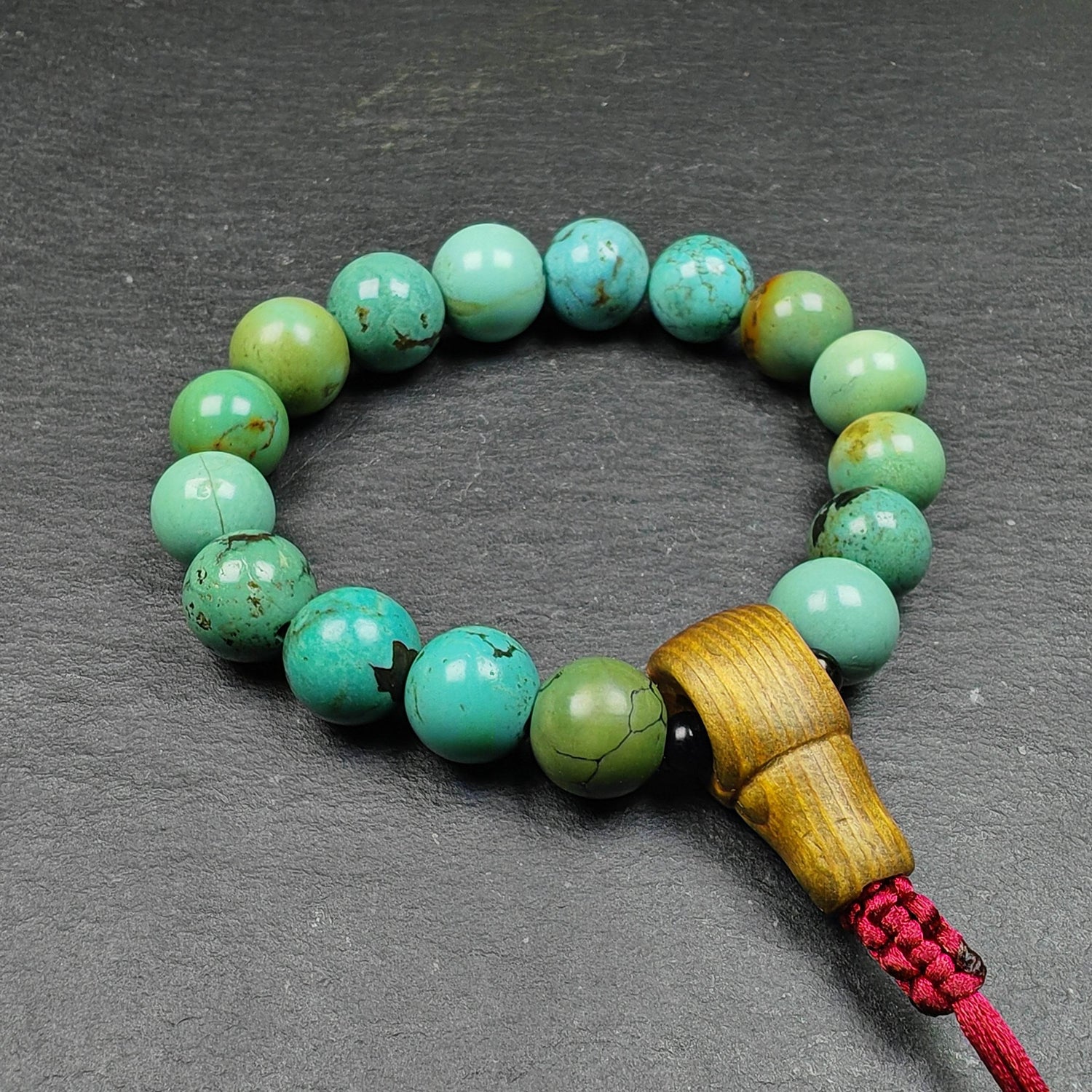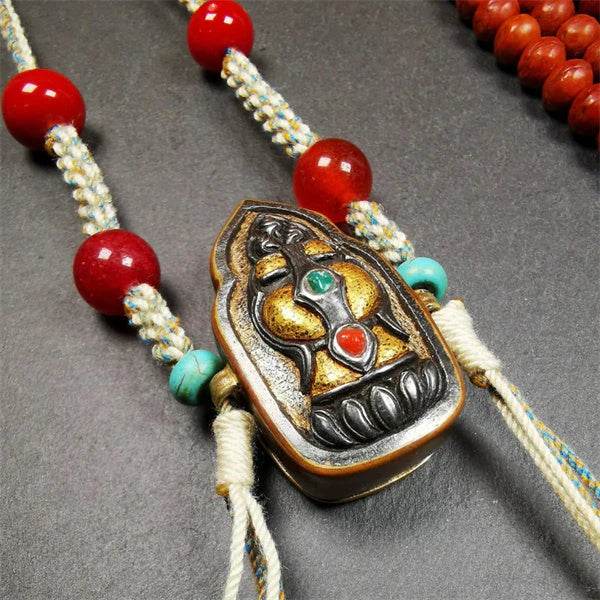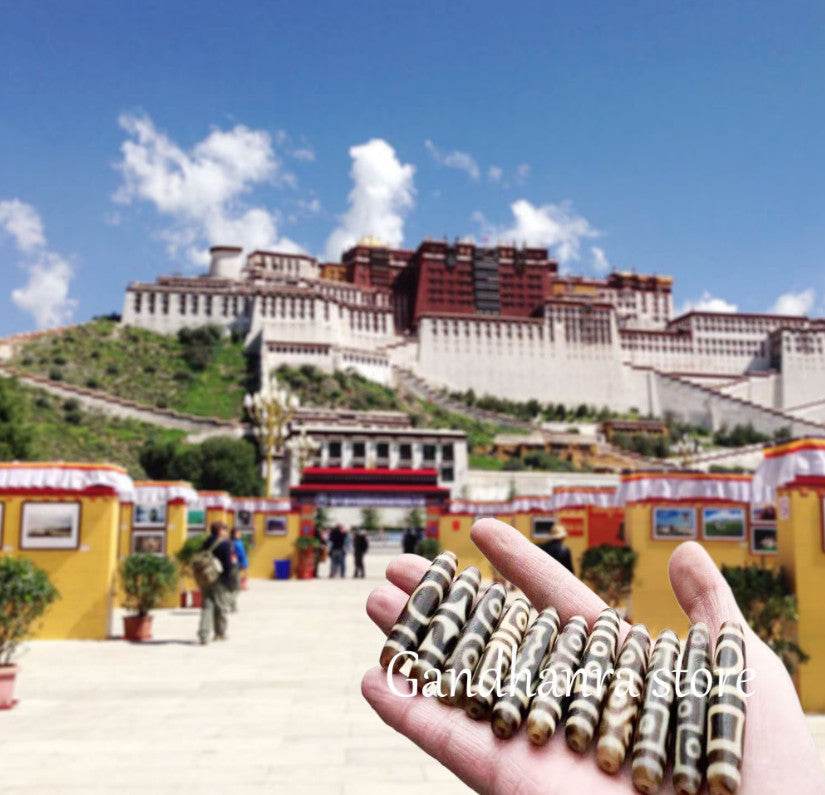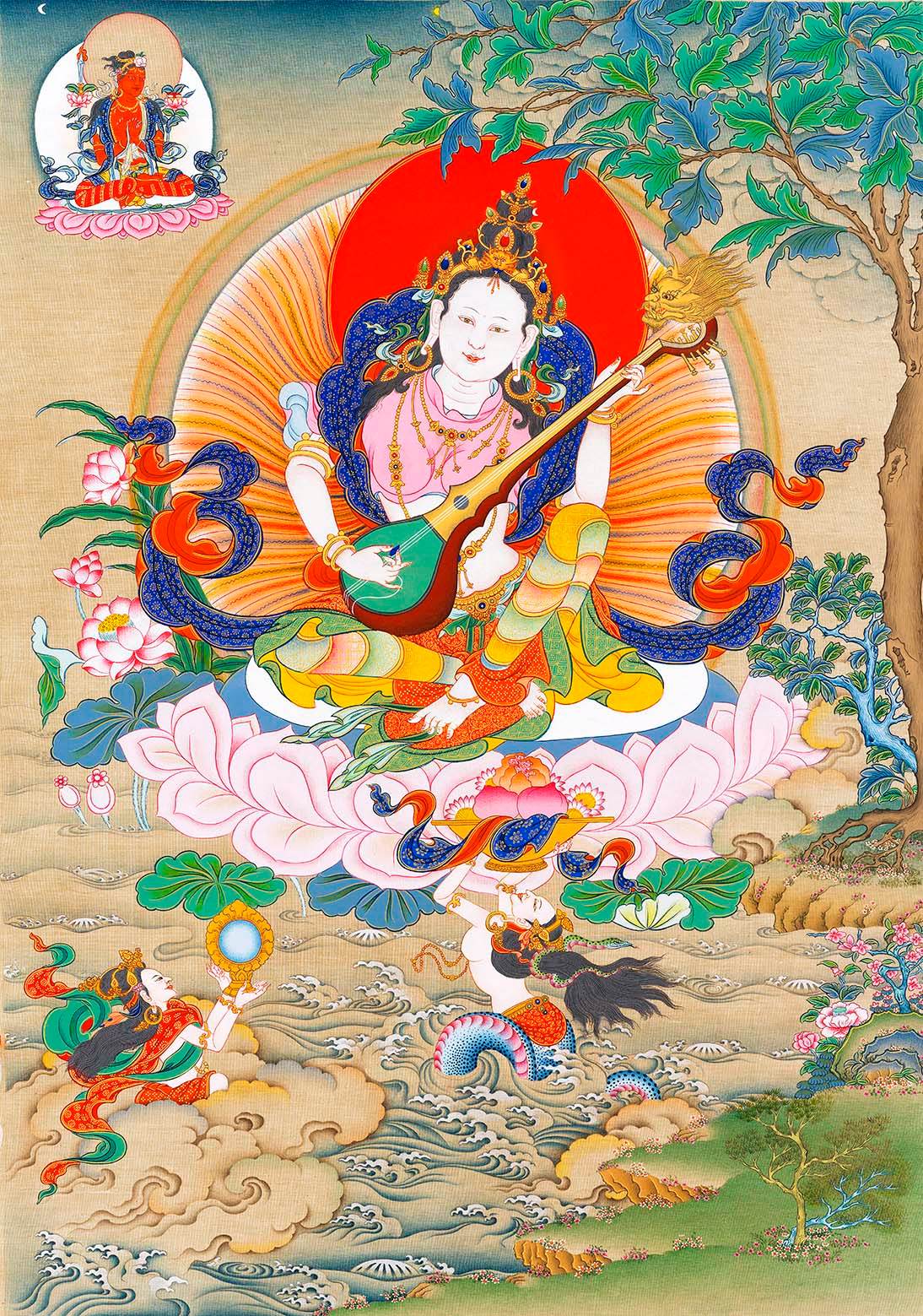
The Connection Between Tibet and Mount Wutai (Part 1)

"Panorama of the Sacred Wutai Mountains", 1864
Collection of the Rubin Museum

Detail from Panorama of the Sacred Wutai Mountains

"Manjusri Attending the Assembly" on the west wall of Cave 220 at Mogao Grottoes, Dunhuang,
with "Map of Mount Wutai" depicted below,
is a masterpiece from the Tibetan Empire period.

"Map of Mount Wutai"
Located on the lower northern section of the west wall
in Cave 159 of the Mogao Grottoes, Dunhuang

"The Famous Large-Scale Map of Mount Wutai in Cave 61 of Mogao Grottoes"
Created after the end of Tibetan rule,
this monumental composition stands in striking contrast
to the smaller-scale Wutai Mountain depictions
from the Tibetan occupation period.
Did Songtsen Gampo Visit Mount Wutai?
In that year, Songtsen Gampo personally led sixteen ministers including Gar Tongtsen and Thönmi Sambhota to Mount Wutai in Han China. To fulfill his pledge with the Tang Emperor (a detail omitted in the Chinese translation of The Pillar Testament), he not only built 108 temples with east-facing gates there, but also established Dharma platforms. Through miraculous displays, he eliminated obstacles for countless Han Chinese people.

"Panorama of the Sacred Wutai Mountains"
Held in the Collection of the Finnish National Museum
This account is derived from The Pillar Testament (Bka’ chems ka khol ma in Tibetan) (paraphrased for readability, not a direct quotation). Traditionally attributed to Songtsen Gampo (whose dates are debated but generally given as 617–650 CE), modern scholarship widely regards the text as an 11th-century or later composition.
Based on available historical evidence, there is virtually no way to confirm Songtsen Gampo’s personal visit to Mount Wutai. Nevertheless, this narrative reveals that the connection between Tibet and Wutai Shan traces back to ancient times.

"Map of Mount Wutai", 18th century
Collection of the Rubin Museum of Art
Only Sangxi Could Enter
Currently, the most reliable early records concerning the connection between Tibet and China's Mount Wutai come from the Tibetan text The Testament of Ba (《སྦ་བཞེད་ཞབས་བཏགས་མ》) and the Chinese historical works Old Book of Tang (Jiu Tangshu) and Cefu Yuangui. Particularly noteworthy is the widely circulated account in The Testament of Ba: the Tibetan envoy Sangxi and four others journeyed to Mount Dewu (Tibetan: ri mgo rde'u shan, i.e., Mount Wutai) to obtain a blueprint of the Manjushri Hall. During their pilgrimage, one companion failed to reach the summit, another reached the top but saw no temples, a third found the temples but could not locate the entrance, and a fourth discovered the gate but became entangled in silk nets and could not enter. Only Sangxi successfully gained admission. After paying homage to Manjushri, he obtained the architectural plans (the Map of Mount Wutai) and returned to Tibet. This event occurred shortly after Trisong Detsen (Khri-srong lde-btsan) ascended the throne, placing it before 755 CE. This suggests that, at least during the reign of Trisong Detsen (742–797)—corresponding to the mid-Tang period in China—a Tibetan Buddhist devotion to Mount Wutai had already begun to take shape.

"Five Manifestations of Mañjuśrī Corresponding to the Five Peaks of Wutai Mountain", 18th century
Collection of the San Diego Museum of Art
Sakya Pandita Never Visited the Physical Wutai Mountain
As time progressed to the eve of the Yuan Dynasty's establishment, Tibetan cultural history records that the immensely influential scholar Sakya Pandita (abbreviated as "Sapaṇ", 1182-1251) was also said to have resided at Mount Wutai. According to accounts, during his stay at Wutai, Sapaṇ transmitted Dharma teachings to a Han Chinese Daoist priest. While he was residing at the Liangzhou court, many pilgrims traveling to Wutai reportedly dreamed that Mañjuśrī was not at Wutai, but rather in Liangzhou. Although historical analysis suggests that the site Sapaṇ visited was not the present-day Wutai Mountain in Shanxi, but rather the "Northern Wutai" of the Western Xia Kingdom, the manner in which Tibetan historical texts associate Sapaṇ, Mañjuśrī, and Wutai Mountain fully demonstrates the sacred status that Wutai and the Mañjuśrī cult held in the Tibetan spiritual imagination.

"Sakya Pandita and His Nephew [Phagpa], 15th Century"
Collection of the Rubin Museum of Art
Upon closer examination, it becomes evident that Tibetan scholars, in constructing this sacred association, subtly integrated the cultural context of Mount Wutai into a Tibetan Buddhist framework. In other words, for Tibet, Mount Wutai was no longer a distant "other," but gradually became internalized as part of its own spiritual landscape. This cultural reimagining found its most concrete expression in the writings of Phagpa (1235–1280), Sakya Pandita’s nephew and future Imperial Preceptor of the Yuan Dynasty.

"Phagpa and Kublai Khan, 17th Century"
Collection of the Rubin Museum of Art
First Tibetan Text on Mount Wutai
In 1257, the 23-year-old Phagpa journeyed to Mount Wutai. During his stay, he composed five devotional hymns, among which A Garland of Pearls: In Praise of Mañjuśrī at Mount Wutai (Tibetan: ’Jam dpal la ri bo rtse lngar bstod pa nor bu’i phreng ba) holds particular significance in contemporary scholarship. Based on extant records, this represents the earliest known Tibetan text directly addressing Mount Wutai, making Phagpa the first Tibetan—since Sangxi’s legendary mission—to verifiably reach the Shanxi-based sacred site.
The Garland of Pearls carries further importance as the first systematic interpretation of Mount Wutai through a Tibetan cultural lens, marking the maturation of Tibet’s Wutai devotional tradition. For instance, the hymn begins:
"ལྷུན་པོའི་རྒྱལ་པོ་རི་བོ་རྩེ་ལྔ་ནི། ། The five-peaked mountain, sovereign of the universe,
རྩ་བ་གསེར་གྱི་དབང་ཆེན་ལྟ་བུ་བརྟན། ། Stands firm as a golden vajra ground.
རྩེ་མོ་བཀོད་ལེགས་ཡོངས་སུ་བསྐོར་བའི་ཚུལ། ། Its summits, perfectly arrayed and encircled,
དབུས་ཀྱི་རི་བོ་སེང་གེ་བསྒྱིངས་པ་བཞིན། ། Resemble the central peak where lions crouch.
བྲག་རི་ཀུནྡའི་མདངས་ལྟར་རབ་ཏུ་དཀར། ། Its cliffs glow white as kumuda flowers,
ཤར་རིའི་རྩེ་མོ་གླང་པོའི་གཙུག་འདྲ་བ། ། The eastern peak, an elephant’s majestic crown,
རྩྭ་མཆོག་ཁ་དོག་ནམ་མཁའི་མདངས་ལྟར་སྔོ། ། Where azure grasses mirror the sky’s hue.
ལྷོ་ཡི་རི་བོ་རྟ་མཆོག་ཉལ་བ་བཞིན། ། The southern slope, a resting celestial steed,
མེ་ཏོག་གསེར་མདོག་ལྡན་པས་རྣམ་པར་བཀྲམ། ། Adorned with golden blossoms’ radiant light.
ནུབ་རི་རྨ་བྱ་གར་བྱེད་ལྟ་བུའི་ཚུལ། ། The western face, a peacock in mid-dance,
ས་གཞི་པདྨ་རཱ་གའི་འོད་ཆགས་འབར། ། Upon earth glowing lotus-garnet bright.
བྱང་རི་མཁའ་ལྡིང་འདབ་གཤོག་བརྐྱང་འདྲ་བ། ། The northern crest, a garuda wings outspread,
མརྒད་མདོག་མཚུངས་ལྗོན་པས་ཡོངས་སུ་གང་། །Clothed in green like jong trees’ tender shade.
..."
—Translated by Professor Tsering
Following the surge of Tibetan cultural influence at Mount Wutai initiated by Phagpa, waves of Tibetan scholars flocked to the sacred site. They engaged in study, established monasteries, and constructed stupas—among which the iconic White Stupa, a masterpiece by Phagpa’s disciple Anige (1244–1306), remains a defining landmark of Wutai today—laying a solid foundation for the next wave of Tibetan cultural prominence.

The Anige White Stupa at Mount Wutai
Image Source: Himalayan Art Resources
Tsongkhapa's Rebirth at Mount Wutai
After the fall of the Yuan Dynasty, Tibetan culture continued to be highly revered in Central China, with Mount Wutai remaining a focal point. During the Ming Dynasty, eminent Tibetan scholars still journeyed to Wutai to conduct religious activities, demonstrating the enduring sanctity of the mountain within Tibetan Buddhist tradition. For instance, following the parinirvāṇa of Tsongkhapa (1357–1419)—the most celebrated scholar of his time across Tibet—many believed he had taken rebirth at Mount Wutai, where he continued his work in the form of a paṇḍita.

"Karmapa Performing Rituals for Emperor Taizu of Ming"
Collection of Palpung Monastery, Dergé, Sichuan

The Life of Tsongkhapa", 18th Century
Rubin Museum of Art, New York
Qianlong Emperor and His Imperial Preceptor Changkya
Nevertheless, Tibetan cultural influence at Mount Wutai reached its zenith during the Qing Dynasty, epitomized by Changkya Rolpai Dorje (1717–1786). As the Imperial Preceptor of the Qing court, Changkya enjoyed deep reverence from the Qianlong Emperor (1711–1799). Of Qianlong’s five pilgrimages to Mount Wutai, four were accompanied by Changkya. The lama not only maintained a residence at Wutai called Zhenhai Temple but also spent nearly every summer from 1750 to 1786—a span of 36 years—in retreat there from the fourth to the eighth lunar month. In 1767, Changkya composed a Tibetan-language Guide to the Sacred Mountain of Clear Coolness (ཞིང་མཆོག་རི་བོ་དྭངས་བསིལ་གྱི་གནས་ཡིག), now identified by scholars as a translation of Chinese mountain gazetteers. Changkya’s prolonged residence and unparalleled impact made Wutai a flourishing center of Tibetan culture during this period—a key reason why Tibetans found profound spiritual resonance there.
(Note: This analysis focuses on sociohistorical dimensions; the evolution of religious connotations related to Mañjuśrī worship falls outside its scope.)


Qianlong Emperor in Thangka Art, Mid-18th Century

"Changkya Rolpai Dorje"
Private Collection







1 則留言
tsveo2